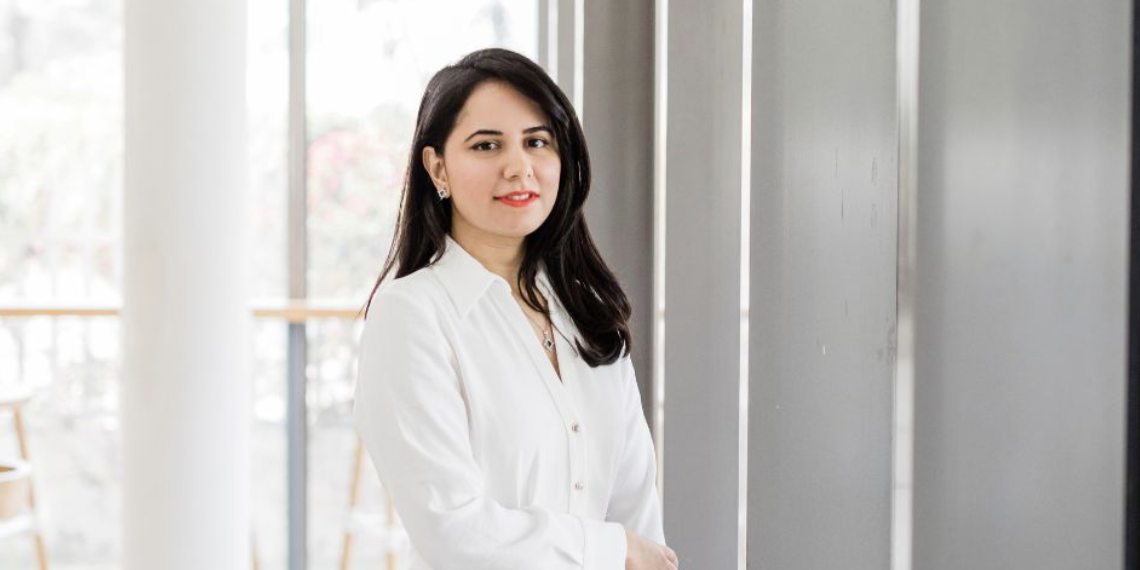COP28 was yet another wake-up call for the fashion industry about its undeniable environmental impact. The discussions stressed that fashion is still a major source of pollution and waste in 2023, highlighting the need for a significant shift in how the industry operates. This means rethinking how clothes are made, sold, and used. In an exclusive interview, we get in-depth insights from Najia Qazi, a designer, sustainability advocate, consultant, and the founder of Sustainable Narrative, on the urgent need to raise awareness about sustainability. Drawing on her experiences with COP28, EXPO 2020, MENA Climate Week, DIFC, Dubai Design Week, Fashion Forward, and the World Green Economy Summit, Qazi shared insights into promoting and practicing sustainability in fashion for both consumers and fashion brands.

Could you provide our readers with a brief overview of Sustainable Narrative and its mission to promote sustainable design solutions?
Sustainable Narrative is a digital platform and a green initiative started with a mission to create awareness and provide sustainable design-based solutions to businesses in Dubai, UAE. We aim to incorporate circular principles and a regenerative business mindset that includes the processes of restoration, renewal of current resources, and the creation of sustainable systems. We are working with clients to lead a wave of innovation and economic growth that safeguards our planet and advances sustainability. Catering to all the industry sectors to transform to reach net zero by 2050, balanced with the sustainable development goals. Our aim is to take ideas as well as concepts from the natural world and turn them into accepted business models with our approach ‘business today from the perspective of tomorrow’. We aim to assist organisations in adopting sustainable practices and strategies. It involves providing expert advice, guidance, and support to help businesses integrate sustainability into their operations, decision-making processes, and overall business strategy. The goal is to enable organisations to achieve long-term environmental, social, and economic sustainability while also considering the needs of future generations. One of the main points that Sustainable Narrative addresses is the unsustainable use of resources. Traditional industries often rely on non-renewable resources and inefficient production processes, leading to excessive waste generation and environmental degradation. Our focus is on developing alternative materials, technologies, and business models that minimise resource consumption and waste generation. They strive to create products and services that are more energy-efficient, use renewable resources, and have a reduced carbon footprint. By doing so, we play a crucial role in shaping a more sustainable and equitable future for all.
Can you share a bit about your personal journey as a designer and sustainability advocate, and what led you to establish Sustainable Narrative?
I have a professional degree in fashion design, and my prior experience has involved working with various clothing brands in the design realm. In that aspect, my work in the past has hugely focused on learning about silhouettes, trends, and materials, where they came from, and the overall design and making process. This exposure naturally intrigued me to learn more about the production and consumption processes. A breakthrough moment was a course on SDGs from the University of Columbia in the US, which sparked an interest in sustainability for me. I decided to further my education by studying sustainable and ethical fashion at Central Saint Martins, London, UK. I was introduced to the current gaps in the fashion industry and beyond, wherein the concept of sustainability was practically missing. I began to question how the entire design system works and decided to find a solution for glaring issues such as the unfair pay gap, the high rate of production leading to overconsumption, excessive waste of resources, etc.
I purposefully decided not to limit my scope to only fashion brands because I realize the importance of the entire economy, which needs to work effectively and efficiently at all scales. This means for large and small businesses, organizations, and individuals across industries, we need to get to a point where we are reducing our impact and bringing positive outcomes, whether it’s on a human or environmental level where they came from, and the overall design and making process. This exposure naturally intrigued me to learn more about the production and consumption processes. A breakthrough moment was a course on SDGs from the University of Columbia in the US, which sparked an interest in sustainability for me.
How has your background influenced your approach to promoting sustainability in the fashion industry?
As we go forward on our path, the aim of Sustainable Narrative is to embrace sustainability as a mandatory choice instead of a corrective action and to live it fully. Personally, this also means for me to continue becoming conscious of my lifestyle, reducing my own footprint and, in turn, being a role model in helping create a green impact through local and international collaborations. On a personal note, I vouch to continue learning and informing myself about the evolution of sustainable efforts across the world, since this is something we simply cannot ignore. Moreover, I believe that a designer’s background, including their education, personal experiences, cultural influences, professional connections, and market trends, can significantly impact their approach to promoting sustainability in the fashion industry. By considering these factors, one can make informed decisions to create eco-friendly, ethically produced clothing that not only benefits the environment but also resonates with the growing number of conscious consumers. We are actively investigating systemic changes that create long-term resilience for our planet, open commercial and economic prospects, and have positive effects on the environment and society. For instance, by altering the way we create and use design products in the UAE, it has the power to completely change our future as a people. We may alter how we use our limited resources and take the environment’s long-term effects into consideration by using the circular design principle.
How can fashion brands improve their supply chain sustainability?
In response to growing awareness about the need for sustainability, fashion brands are now focusing on improving their supply chain sustainability. This can be achieved by adopting sustainable materials and practices. Fashion brands can opt for eco-friendly materials that can help reduce the environmental impact but also contribute to a circular economy. Additionally, using low-impact dyes and reducing water consumption in production processes can significantly improve the overall sustainability of the supply chain. Collaborating with sustainable suppliers can also be very helpful, brands should conduct thorough research and due diligence to identify suppliers that adhere to ethical and sustainable practices. Implementing transparent and traceable supply chains: By implementing blockchain technology to track the journey of raw materials, production processes, and finished products. This enables brands to identify and address any issues related to labor rights, environmental impact, and waste management. Transparency also helps build consumer trust and loyalty. Reducing waste and embracing a Circular Economy can minimise waste by implementing strategies such as designing for durability, repairability, and recyclability. They can also embrace a circular economy by incorporating garment rental, repair, and resale services. This not only reduces waste but also extends the life cycle of garments, thereby conserving resources. They should also engage in sustainable marketing and communication by sharing their sustainability efforts through various channels, including social media, websites, and in-store displays. This not only raises awareness about sustainability but also encourages customers to make more eco-conscious choices.
Despite the fact that textile waste is almost entirely recyclable, approximately 75% of it ends up in landfills worldwide. What urgent steps should be taken to establish an efficient textile waste recycling system, ensuring that the vast majority of this recyclable resource is diverted from landfills?
To address this issue and ensure that most of this recyclable resource is diverted from landfills, the following urgent steps should be taken:
- Raising public awareness about the importance of textile recycling is crucial. Many people are unaware of the recycling options available for textile waste or the environmental impact of sending it to landfills.
- Public awareness campaigns can be conducted through various channels, such as social media, community events, and educational programs.
- Establishing a well-organised collection and sorting infrastructure in the UAE is essential for an efficient textile waste recycling system. This includes setting up collection bins in public places, partnering with clothing retailers and manufacturers, and investing in advanced sorting technologies to separate different types of textile materials. Further collaboration with recycling facilities and manufacturers is vital for creating a closed-loop system for textile waste. Recycling facilities can process the collected textile waste and transform it into new products, while manufacturers can incorporate recycled materials into their production processes.
- UAE governments can play a significant role in promoting textile waste recycling by implementing policy changes and offering incentives. This can include introducing extended producer responsibility (EPR) policies, which hold manufacturers accountable for the environmental impact of their products, and offering tax breaks or subsidies for companies that invest in textile recycling infrastructure.
- Lastly, investing in research and development can lead to advancements in textile recycling technologies, making the process more efficient and cost-effective. UAE governments, academic institutions, and private companies should collaborate to fund research projects and support startups working on innovative textile recycling solutions.
COP28 featured prominent fashion industry figures and important groups coming together. From your perspective, what were the key takeaways, and what strategic steps can the industry take to steer toward a more sustainable future?
Being actively involved in COP28, the key takeaways from this event included a heightened awareness of the environmental impact of the fashion industry, a recognition of the need for systemic change, and a commitment to collaboration and innovation to drive sustainable practices. Firstly, there was the acknowledgement of the significant environmental footprint of the fashion industry. This includes the industry’s contribution to carbon emissions, water pollution, and waste generation. The discussions at COP28 underscored the urgency of addressing these issues and highlighted the need for immediate action. Another key takeaway was the recognition that achieving sustainability in the fashion industry requires systemic change. This involves rethinking traditional business models, supply chains, and consumer behaviour. It emphasised the importance of integrating sustainability into every aspect of the industry, from design and production to distribution and consumption. Furthermore, the importance of collaboration and innovation in driving sustainable practices within the fashion industry. Participants at the event emphasised the need for partnerships between stakeholders, including fashion brands, manufacturers, policymakers, and consumers. Additionally, there was a focus on leveraging technological advancements and innovative solutions to reduce environmental impact and promote sustainable fashion.
I do believe that to steer toward a more sustainable future, the fashion industry can take several strategic steps based on the discussions and outcomes of COP28:
- Embracing the principles of the circular economy can significantly reduce waste and promote resource efficiency within the fashion industry. This involves designing products for longevity, implementing recycling programs, and exploring innovative materials that can be reused or repurposed.
- Implementing transparency and traceability measures throughout the supply chain can enhance accountability and enable consumers to make informed choices. This includes disclosing information about sourcing, production processes, and environmental impact.
- Shifting towards sustainable materials such as organic cotton, recycled fibers, and biodegradable textiles can reduce the environmental footprint of fashion production. Additionally, investing in eco-friendly manufacturing processes and renewable energy sources can further advance sustainability goals.
- Educating consumers about sustainable fashion choices and promoting responsible consumption habits is crucial. Encouraging mindful purchasing decisions, promoting garment care practices that extend product lifespans, and fostering a culture of reuse and repair can contribute to a more sustainable fashion ecosystem.
The popularity of thrifting has come and gone throughout the years and its resurgence is evident in recent times. How do you see the role of thrifting in reducing the environmental footprint of the fashion industry?
The popularity of thrifting has experienced multiple waves throughout the years, and its resurgence in recent times has sparked interest in its role in reducing the environmental footprint of the fashion industry.
We need to realize that thrifting plays a significant role in reducing waste in the fashion industry. When consumers opt for second-hand clothing, they are essentially reducing the demand for new clothing. This, in turn, decreases the need for new production, ultimately leading to a reduction in textile waste. Furthermore, thrifting contributes to the recycling of existing garments, giving them a second life and preventing them from ending up in landfills.
Also, thrifting contributes to resource conservation by reducing the demand for new materials and energy consumption in the fashion industry. The production of new clothing requires a significant amount of resources, including water, energy, and raw materials such as cotton, polyester, and other synthetic fibers. By choosing thrift, consumers help decrease the demand for these resources, thereby conserving them for future use. It encourages a more sustainable fashion industry by supporting the circular economy, where resources are reused and recycled rather than being discarded after a single use. Thrift stores, consignment shops, and online platforms in UAE for second-hand clothing provide consumers with access to a wide range of clothing options, making it easier for them to adopt a more sustainable fashion lifestyle.
Furthermore, it contributes to the reduction of greenhouse gas emissions associated with the fashion industry. According to a study by the World Resources Institute, if global clothing consumption continues to grow at its current rate, it will lead to a 50% increase in greenhouse gas emissions by 2030.
In conclusion, thrifting plays a vital role in reducing the environmental footprint of the fashion industry. By reducing waste, conserving resources, and promoting sustainable fashion, thrifting contributes to a more environmentally friendly fashion industry. It is essential for consumers to recognise the benefits of thrifting in the UAE and incorporate it into their fashion choices to create a more sustainable future.
As sustainability and climate change gain mainstream attention, greenwashing is also increasing. How can consumers proactively educate themselves about this?
I think consumers can proactively educate themselves about greenwashing by conducting thorough research and due diligence before making purchasing decisions. This involves looking beyond the surface-level claims made by companies and delving into the specifics of their environmental initiatives and practices. By examining a company’s track record, certifications, and transparency in reporting environmental impacts, consumers can gain a clearer understanding of its commitment to sustainability. Also, familiarizing oneself with environmental labels and certifications is crucial in identifying genuine eco-friendly products and services.
Consumers should critically evaluate the marketing claims made by companies regarding their environmental practices. This involves scrutinizing the language used in advertisements, product packaging, and promotional materials. Look for specific details and evidence supporting the environmental claims rather than vague or generalized statements. Additionally, be cautious of terms like “natural,” “eco-friendly,” or “green” that are not backed by verifiable evidence.
Transparency and accountability are key indicators of a company’s genuine commitment to sustainability. The customers should seek companies that openly disclose their environmental practices, goals, and progress. This can include accessing sustainability reports, corporate social responsibility initiatives, and public statements regarding environmental stewardship. Companies that are transparent about their environmental impact are more likely to be authentic in their sustainability efforts. Relying on independent sources and third-party verification can provide consumers with unbiased information about a company’s environmental performance.
Lastly, consumer activism plays a significant role in holding companies accountable for their environmental claims. By participating in various initiatives such as petitions, boycotts, or advocacy campaigns, individuals can raise awareness about greenwashing practices and demand greater transparency from corporations. Engaging with like-minded individuals through social media platforms or community organisations can amplify the impact of consumer activism efforts as a result.
What emerging trends do you see in sustainable fashion? Can 2024 deliver radical change for the industry?
The fashion industry has been undergoing a significant shift towards sustainability in recent years, and several emerging trends are shaping the future of sustainable fashion. One of the key trends is the increasing adoption of eco-friendly and recycled materials in clothing production. This includes the use of organic cotton, hemp, and other sustainable fabrics, as well as innovative technologies for recycling and upcycling materials. Another trend is the rise of circular fashion models, which focus on minimizing waste and maximizing the lifespan of garments through practices such as clothing rental, resale, and repair services. Additionally, there is a growing emphasis on transparency and ethical practices throughout the supply chain, with consumers demanding greater accountability from fashion brands regarding their environmental and social impact.
As we look ahead to 2024, there is potential for radical change in the fashion industry, driven by these emerging sustainable trends. The increasing consumer awareness and demand for sustainable fashion are likely to push more brands to adopt environmentally friendly practices and prioritse ethical sourcing. This shift can lead to a broader industry-wide transformation towards more sustainable and responsible production methods. Furthermore, advancements in technology and innovation are expected to play a significant role in driving change with the development of new sustainable materials, manufacturing processes, and supply chain management solutions. Collaborations between fashion brands, environmental organisations, and policymakers may also lead to the implementation of industry-wide standards and regulations that promote sustainability.
In conclusion, 2024 holds the promise of delivering radical change for the fashion industry by further embracing sustainable practices, fostering innovation, and meeting the evolving demands of conscious consumers.
Any further advice that you’d like to share with our readers on how they can educate themselves about sustainable fashion and what role can they, as consumers, play in driving change?
As consumers, individuals have the power to drive change in the fashion industry by making conscious choices. They can reach out to their favourite local or international brands and ask questions about their sustainability practices. This can lead to increased transparency and a push for more sustainable practices. Lastly, educate friends, family, and social media users about the importance of sustainable fashion, that can help create a broader awareness of the global issue and encourage more people to make green choices.




